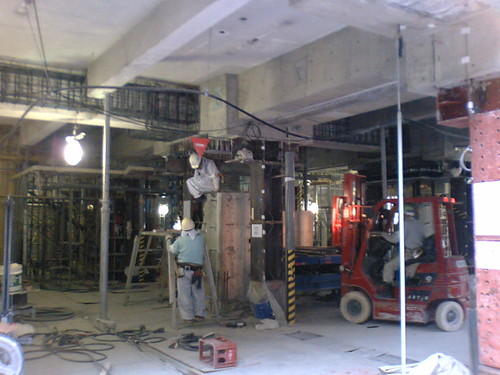Do you know what retrofitting is? Or why it is becoming increasingly important in the built environment? Read on.
Put simply, retrofitting means adding new technology or features to older systems (thanks Wikipedia). In the context of the built environment, retrofitting is becoming an increasingly popular alternative to demolition and rebuild. The Oxford Institute of Sustainable Development here at Oxford Brookes is part of a team taking part in a research project called RETROFIT 2050. They define urban retrofitting as: "the directed alteration of the fabric, form or systems which comprise the built environment in order to improve energy, water and waste efficiencies." Here's what they have to say about retrofitting:
"Buildings account for 45% of energy use in the UK, the equivalent of all transport and manufacturing combined. Since 87% of existing buildings will still be standing in 2050, retrofitting our current building stock is a vital part of meeting emissions reductions targets and using energy in a more efficient, sustainable way. In response to this, retrofit projects have emerged from the public, private and voluntary sectors, taking advantage of energy efficiency improvements and renewable energy sources to address a broad range of socio-economic agendas including averting climate change, ensuring resource security and tackling fuel poverty.
While a growing number of retrofit projects have been emerging around the world, action so far has been piecemeal. There is an opportunity to take a more holistic approach to retrofitting in order to better learn and circulate lessons of best practice and increase the scale and effectiveness of retrofitting activities. The RETROFIT 2050 project aims to bridge this gap and explore what can be achieved from taking a more systematic, holistic approach to sustainability in the built environment."
 |
| Retrofit in progress - photo by Hibino via Flickr |
Put simply, retrofitting means adding new technology or features to older systems (thanks Wikipedia). In the context of the built environment, retrofitting is becoming an increasingly popular alternative to demolition and rebuild. The Oxford Institute of Sustainable Development here at Oxford Brookes is part of a team taking part in a research project called RETROFIT 2050. They define urban retrofitting as: "the directed alteration of the fabric, form or systems which comprise the built environment in order to improve energy, water and waste efficiencies." Here's what they have to say about retrofitting:
"Buildings account for 45% of energy use in the UK, the equivalent of all transport and manufacturing combined. Since 87% of existing buildings will still be standing in 2050, retrofitting our current building stock is a vital part of meeting emissions reductions targets and using energy in a more efficient, sustainable way. In response to this, retrofit projects have emerged from the public, private and voluntary sectors, taking advantage of energy efficiency improvements and renewable energy sources to address a broad range of socio-economic agendas including averting climate change, ensuring resource security and tackling fuel poverty.
While a growing number of retrofit projects have been emerging around the world, action so far has been piecemeal. There is an opportunity to take a more holistic approach to retrofitting in order to better learn and circulate lessons of best practice and increase the scale and effectiveness of retrofitting activities. The RETROFIT 2050 project aims to bridge this gap and explore what can be achieved from taking a more systematic, holistic approach to sustainability in the built environment."
For more information on RETROFIT 2050 take a look at their website.

No comments:
Post a Comment
Note: only a member of this blog may post a comment.